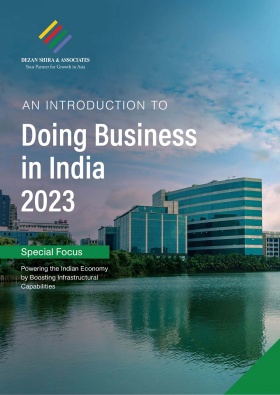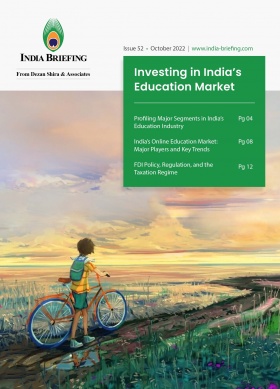Mandatory GST E-invoicing in India: Annual Turnover Threshold Lowered
GST e-invoicing in India will become mandatory for all businesses with an annual turnover of over INR 50 million starting August 1, 2023. The previous threshold was INR 100 million. This is a significant step towards formalizing India’s small businesses and reducing tax evasion. With the adoption of GST e-invoicing, businesses will be better equipped to synchronize their sales data and simplify input tax credit claims, ultimately contributing to a broader GST base and greater transparency in the taxation system.
The Indian government has mandated that businesses with an annual turnover exceeding INR 50 million adopt e-invoicing for all business-to-business (B2B) transactions under the Goods and Services Tax (GST) regime starting from August 1, 2023.
This reduces the previous threshold from INR 100 million and aims to formalize small businesses, which form the backbone of the Indian economy.
The GST Network’s technology providers have been instructed to update the portal’s capacity by the end of July 2023 to avoid any glitches.
What is e-invoicing and why has it been introduced?
E-invoicing is a standardized format that allows machines to read invoices, facilitating the detection of false input tax credit (ITC) claims, expanding the GST base, and improving compliance.
The Indian government’s decision to mandate e-invoicing aims to streamline tax compliance, boost revenue collection, and synchronize sales data between small business vendors and large corporate clients.
This simplifies the process of claiming tax credit and encourages businesses to operate within the formal economy, ultimately expanding the country’s tax base.
What are the advantages of e-invoicing?
- Backward integration and automation of the tax return filing process: The relevant details of the invoices are auto-populated in the various returns.
- Lower costs and faster returns on investment: With the conversion to e-invoicing, 60 to 80 percent of the process costs per invoice are eliminated.
- More efficient processes and higher compliance: E-invoicing ensures more efficient and transparent processes, thereby facilitating higher standards of compliance.
- Added security: Exchange of all invoices through encrypted transmission procedures ensures better safety.
- Reduced errors: E-invoicing helps in plugging the major gap in data reconciliation under GST to reduce mismatch errors.
- Better cash flow: Immediate delivery of invoices cuts the time lag in payment and thus improves cash flow.
- Greater transparency: Automated processing of incoming invoices with workflow-based approval processes ensures greater transparency.
How is e-invoicing being implemented under GST?
India has implemented e-invoicing in phases to ensure uniformity and interoperability within the GST ecosystem. Here are the phases of implementation and their respective turnover thresholds:
- Phase 1 (from October 1, 2020): E-invoicing became mandatory for B2B transactions for companies with a turnover of INR 5 billion.
- Phase 2 (from January 1, 2021): The turnover threshold for mandatory e-invoicing was lowered to INR 1 billion.
- Phase 3 (from April 1, 2021): The threshold was further revised to INR 500 million.
- Phase 4 (from April 2022): E-invoicing became mandatory for businesses with a turnover exceeding INR 200 million.
- Phase 5 (from October 2022): E-invoicing became mandatory for businesses with an annual turnover of INR 100 million.
Are there any exemptions for e-invoicing under GST?
Exemption for entities
E-invoicing shall not be applicable to the following categories of GST registered persons irrespective of the turnover:
- Insurer or a banking company or a financial institution, including an NBFC
- Registered person supplying passenger transportation services
- Goods Transport Agency (GTA)
- Registered person supplying services by way of admission to the exhibition of cinematographic films in multiplex services
- Special economic zone (SEZ) unit (excluded via CBIC Notification No. 61/2020 – Central Tax)
Exemption for documents
- Bill of supply
- Self-invoice in case of RCM u/s 9(4)
- Advance payment
- Delivery challan
- Financial debit/ credit note
Exemption for transactions
- B2C transactions
- Non-GST supplies (alcoholic liquor, petrol, diesel etc.)
- Bill of entry in case of Import
- Nil rated or exempted supplies
How does the e-invoice generation process work?
E-invoicing requires the user to generate the invoice data in the prescribed format, which is JavaScript Object Notation (JSON), either using the enterprise resource planning (ERP)/business management software or offline tool provided by the GST portal.
Following this, the e-invoice is to be uploaded to the Invoice Registration Portal (IRP), which further validates and authenticates the invoice data with the Invoice Reference Number (IRN) and QR code.
The process to generate e-invoice is mentioned below.
Registration on the e-invoice system
Visit the IRP portal
- If a taxpayer is registered on the e-way bill portal: In this case, a taxpayer can use the same login credentials to login onto the e-invoice portal.
- If a taxpayer is not registered on the e-way bill portal: In this case, the taxpayer should have a GSTIN and mobile number registered with the GST system. Once they enter the URL of the e-invoice system, the registration will appear. (A GSTIN, or GST Number, is a unique 15-digit alphanumeric code assigned to individuals or businesses upon GST registration.)
Registration
A first-time GSTIN can register by clicking on the e-invoice registration tab, which will open the e-invoice registration form. Once the form is filled, the taxpayer must verify the form with a one-time password (OTP), which will be sent to the registered mobile number.
Application Programming Interfaces (APIs) facilitate the communication and exchange of data between taxpayers or GST Suvidha Providers (GSPs) and the e-invoice system. In case e-way bill API access is not available, the taxpayer will have first to register themselves on the e-invoice portal. API can be accessed in the following ways:
- Direct API access: A taxpayer with a turnover higher than INR 200 million can use direct API to connect with IRP. For this direct API integration, a taxpayer needs to test the API integration in a sandbox environment (https://einv-apisandbox.nic.in/) and then send the test summary report to support.einv.api@gov.in. After verification, the taxpayer will be provided API production details.
- API access through GSP: This is the fastest way to connect with IRP as it provides scalability along with real-time support. An enterprise can work with massive volumes as the GSP ensures stable connection with fast performance.
Creation of the invoice on the taxpayer’s ERP
While generating invoices in the usual manner, taxpayers need to adhere to specific criteria for electronic reporting.
This involves following the e-invoice schema and including mandatory parameters. To meet these requirements, sellers must ensure that their accounting or billing software is capable of producing a JSON file for the final invoice.
Sellers can create this JSON file using the following methods:
- Utilizing an accounting and billing system that supports e-invoicing.
- Using a utility tool that interacts with the accounting/billing system or ERP, such as an Excel/Word document or a mobile app.
- Employing an offline tool that allows manual input of invoice data to generate e-invoices.
Uploading of JSON
Every business-to-business invoice generated through accounting software or other utilities is converted into an invoice JSON format and uploaded to the IRP system. If the ERP software is integrated with the IRP portal through a GST Suvidha Provider, the upload of the JSON file is automated, allowing the system to directly send the necessary information to the IRP portal.
Verification of e-invoice JSON
In this step, the IRP system validates the e-invoice JSON and checks the central registry of GST for any duplication.
Generation of IRN
After successful validation of e-invoice JSON, the IRP system will generate the IRN. Additionally, the e-invoice JSON will be updated with a digital signature along with a QR code.
The QR code will consist of the following parameters:
- GSTIN of supplier
- GSTIN of recipient
- Invoice number as given by supplier
- Date of generation of the invoice
- Invoice value (taxable value and gross tax amount)
- Number of line items
- HSN code of the main items (the line item having the highest taxable values)
- The unique IRN (hash)
Receipt of a digitally signed e-invoice JSON
In this step, the digitally signed e-invoice JSON along with QR code is sent to the supplier. The IRN and QR code will be printed on the invoice before issuing it to the buyer. In case the ERP and IRP are integrated via GSP, the software will automatically fetch and print such details.
Transfer of data to e-way bill system and GST system
Once the invoice JSON data is uploaded, it will be shared with the e-way bill and GST system, for preparing e-waybills and for auto-population of GST return.
- Part-A of e-way bill will be auto-populated with e-invoice data
- GSTR-1 of the supplier will be auto-populated as per the e-invoice details uploaded into IRP portal
- GSTR-2A will be updated, giving a real-time view to the buyer
Also read
- Changes in GST E-Invoice Rules Notified in 2022: What Businesses Should Note
- OIDAR Digital Services in India: GST Applicability and Compliance
About Us
India Briefing is produced by Dezan Shira & Associates. The firm assists foreign investors throughout Asia from offices across the world, including in Delhi and Mumbai. Readers may write to india@dezshira.com for more support on doing business in India.
We also maintain offices or have alliance partners assisting foreign investors in Indonesia, Singapore, Vietnam, Philippines, Malaysia, Thailand, Italy, Germany, and the United States, in addition to practices in Bangladesh and Russia.
- Previous Article Inaugural India-EU Trade and Technology Council Ministerial Meeting at Brussels
- Next Article September 30 Deadline Approaches to Exchange India’s 2000-Rupee Note








